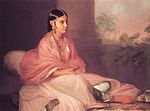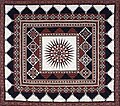Kantha

Kantha,also spelledkantaorqanta,is a type of embroidery craft inBangladeshand eastern regions of India, particularly in theIndian statesofWest Bengal,TripuraandOdisha.In Odisha, oldsarisare stacked on each other and hand-stitched to make a thin piece ofcushion.This is normally used above a bed cushion or instead of a cushion.[1]"Kanthasaris"are traditionally worn by women inBengalregion.[2]In these days, embroidery is stitched, popularly known as 'kantha stitched ", on sari,kurta(or panjabi) andchuridarand many other garments and gaining popularity due to their aesthetic value and handmade characteristics.
Kantha stitching is also used to make simple quilts, commonly known asnakshi kantha.Women in Bengal typically use old saris and cloth and layer them with kantha stitching to make a light blanket, throw, or bedspread, especially for children. Kantha is very popular with tourists visiting theBengalregion of the Indian subcontinent.
Weave[edit]
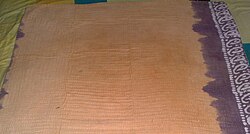
Kantha is a form of embroidery often practised byrural women.The traditional form of Kantha embroidery was done with softdhotisand saris, with a simple running stitch along the edges. Depending on the use of the finished product they were known asLepkanthaorSujni Kantha.
The embroidered cloth has many uses including shawls, covers for mirrors, boxes, and pillows. In some cases, the entire cloth is covered with running stitches, employing beautiful motifs of flowers, animals birds and geometrical shapes, as well as themes from everyday activities. The stitching on the cloth gives it a slightly wrinkled, wavy effect. Contemporary kantha is applied to a wider range of garments such as sarees, dupatta, shirts for men and women, bedding and other furnishing fabrics, mostly using cotton and silk.Modern Kantha-stitch craft industry involves a very complex multi-staged production model.[3]
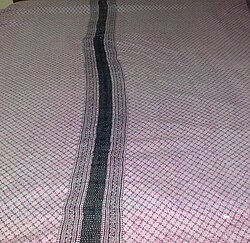
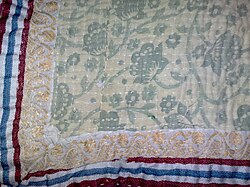
See also[edit]
References[edit]
- ^India. Office of the Registrar General (1962).Census of India, 1961: Orissa.Manager of Publications.
- ^"One stitch at a time - The Hindu".The Hindu.25 September 2014.
- ^Roy, Paramita and Sattwick Dey Biswas (2011). Opportunities and Constraints of the Kantha-stitch craftswomen in Santiniketan: a value chain analysis. Journal of Social Work and Social Development (ISSN 2229-6468). pp. 5–9.
Further reading[edit]
- The Art of Kantha embroidery,byNiaz Zaman.University Press, 1993.ISBN984-05-1228-5.
- Jasleen Dhamija(2004).Asian embroidery.Abhinav Publications.ISBN81-7017-450-3.
- Kantha: the embroidered quilts of Bengal,by Darielle Mason, Pika Ghosh, Katherine Hacker, Anne Peranteau. Yale University Press, 2010.ISBN0300154429.
- Kantha,by John Gillow, Pratapaditya Pal, Courtenay McGowen, and Rob Sidner. Mingei International Museum and Radius Books, 2017.ISBN9781942185192.
- Kantha Work,by Juby Aleyas Koll.Sarah's Hand Embroidery Tutorials,2021.




